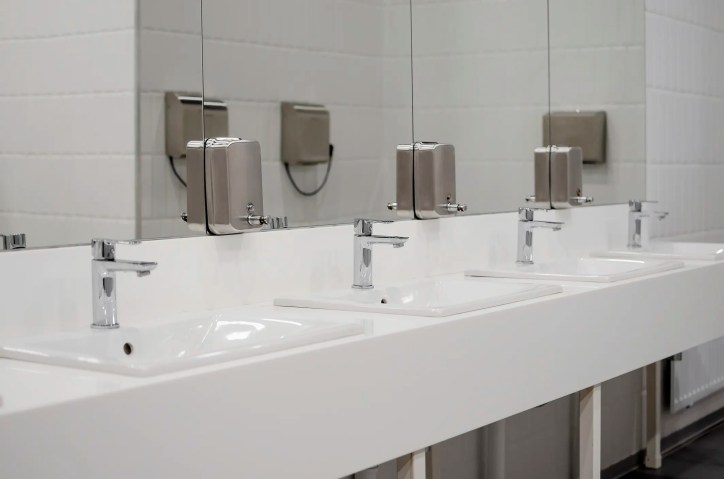The Occupational Safety and Health Administration (OSHA) mandates that every employer provide adequate sanitation facilities for their workforce. These guidelines apply to office environments, factories, and also temporary worksites such as construction zones.
Staying compliant with OSHA restroom requirements in the workplace isn’t just about avoiding penalties; it’s about creating a safer, more sanitary, and more efficient job site.
Toilet Count Requirements (General Workplaces)
OSHA’s general industry standards (29 CFR 1910.141) outline the minimum number of toilets that must be provided based on the number of employees:
- 1 toilet for 15 or fewer employees
- 2 toilets for 16–35 employees
- 3 toilets for 36–55 employees
- 4 toilets for 56–80 employees
- 5 toilets for 81–110 employees
- 6 toilets for 111–150 employees
- 1 additional toilet for every 40 workers beyond 150
These numbers are designed to ensure minimal wait times and sufficient privacy for all employees. It’s important to note that urinals do not count toward the minimum toilet requirement.
Restroom Design & Maintenance Standards
In addition to quantity, OSHA also sets expectations for the condition and accessibility of workplace restrooms:
- Toilets must be readily accessible to all employees at all times.
- They must be clean, sanitary, and well-lit, with adequate ventilation.
- Toilet paper must be provided in each stall.
- Facilities must be maintained regularly to ensure hygiene and usability.
For worksites that don’t have permanent structures, such as active construction zones, portable sanitation solutions like temporary restrooms or portable toilets must be deployed to meet these standards.
OSHA Restroom Requirements for Construction Sites
For construction crews working long shifts in outdoor environments, access to clean restrooms and handwashing stations is a basic necessity, not a luxury.
Construction sites pose unique sanitation challenges. There are often no permanent structures, and workers may be spread across a wide area. OSHA has specific standards for these types of environments under 29 CFR 1926.51(c), which governs sanitation for construction work.
How Many Toilets Are Required?
For active construction zones, OSHA requires:
- 1 toilet for 20 or fewer employees
- 1 toilet seat and 1 urinal for every 40 employees if there are 21–200 workers
- 1 toilet seat and 1 urinal per 50 employees when there are 201+ workers
These facilities must be:
- Easily accessible and located within a reasonable distance from work zones
- Regularly serviced, cleaned, and restocked
- Well-ventilated to control odor and bacteria buildup
- Enclosed for privacy, even if they are temporary units
For job sites with long shifts or multiple crews working overlapping hours, it’s best to plan for peak usage, not just average headcount. Overestimating your needs reduces wait times, keeps workers on schedule, and improves overall job site morale.
ADA and Accessibility Considerations
Larger construction projects, especially those with more than 10 employees on-site, should also include at least one ADA-compliant restroom to ensure accessibility for all workers. These units are typically larger, featuring ground-level entry, handrails, and a wider turning radius to accommodate wheelchairs and other mobility aids.
OSHA Requirements for Handwashing Stations
Restrooms alone aren’t enough to maintain workplace hygiene. Handwashing stations are a critical part of OSHA’s sanitation standards, particularly on construction sites where employees may be exposed to dust, solvents, adhesives, and other potentially hazardous materials.
When Are Handwashing Stations Required?
According to OSHA guidelines:
- A handwashing station is required wherever a toilet is provided on-site.
- For sites using paint, coatings, concrete, or adhesives, handwashing must be done with soap and water, not just hand sanitizer.
- If food is prepared, handled, or consumed at the job site, hand hygiene access is mandatory.
How Many Stations Are Needed?
Construction crews often rely on portable hand washing stations for compliance, especially in remote or developing job sites. OSHA suggests at least 1 handwashing station per 20 employees.
Each unit must include:
- Running water (warm if feasible)
- Soap or other cleaning agent
- Single-use paper towels or air-drying devices
- A greywater collection container or proper drainage
- Clear signage and easy accessibility
These units are built for durability, portability, and easy refilling, ensuring you meet hygiene codes without adding logistical headaches.
Contributing Author: John to Go
John To Go is a family-owned portable restroom and sanitation rental company that has been serving customers across New York, New Jersey, and several major Florida counties since 2004. Known for its iconic bright purple porta potties, the company provides everything from standard portable toilets to luxury restroom trailers, ADA-compliant units, handwashing stations, and shower trailers. The team values quick deliveries and impeccable cleanliness, offering flexible rental options for construction sites, outdoor events, and even emergencies.
